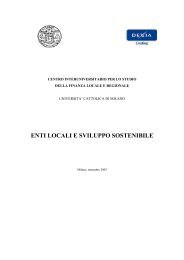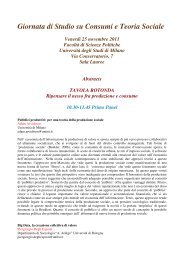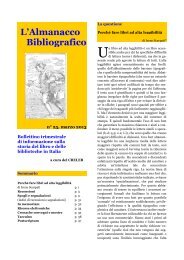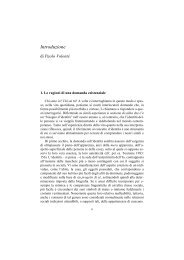Convegno Internazionale - Centri di Ricerca - Università Cattolica ...
Convegno Internazionale - Centri di Ricerca - Università Cattolica ...
Convegno Internazionale - Centri di Ricerca - Università Cattolica ...
Create successful ePaper yourself
Turn your PDF publications into a flip-book with our unique Google optimized e-Paper software.
<strong>Convegno</strong> <strong>Internazionale</strong><br />
QUESTIONI DI MODA<br />
Milano, 7 Maggio 2004<br />
Aula Pio XI<br />
<strong>Università</strong> <strong>Cattolica</strong> del Sacro Cuore<br />
L.go Gemelli, 1<br />
THE GLOBALISATION OF CULTURE:<br />
THE FASHION INDUSTRY AS A CASE STUDY<br />
Diana Crane, University of Pennsylvania<br />
Abstract<br />
Globalization has become an immensely popular topic among social scientists in spite of the fact that<br />
the phenomenon is poorly defined and <strong>di</strong>fficult to research systematically. In this paper, cultural<br />
globalization—as opposed to economic, political, or technological globalization—refers to the<br />
transmission or <strong>di</strong>ffusion across national borders of various forms of me<strong>di</strong>a and arts, inclu<strong>di</strong>ng<br />
decorative or applied arts. I will examine the production and <strong>di</strong>ssemination of fashion and clothing as a<br />
form of cultural globalization.<br />
Surprisingly, there is little agreement or even <strong>di</strong>scussion concerning what constitutes<br />
transmission or <strong>di</strong>ffusion on a global scale. In fact, however, cultural globalization generally refers to<br />
cultural products or artifacts that are circulated among advanced or advancing countries, particularly<br />
those that constitute desirable markets or that possess sufficient levels of income for investment in the<br />
arts and in industries that produce cultural artifacts. It is important to realize that cultural globalization<br />
is no longer conceptualized in terms of the emergence of a homogenized global culture correspon<strong>di</strong>ng<br />
to a McLuhnian global village. Instead, cultural globalization is recognized to be a complex and <strong>di</strong>verse<br />
phenomenon consisting of global cultures in the plural, originating from many <strong>di</strong>fferent nations and<br />
regions.<br />
Assuming that all forms of culture construct and deconstruct social identities and social<br />
relations, cultural globalization raises important and controversial issues concerning its effects on<br />
national and local cultures and the nature of their responses to it. What are the implications for our<br />
understan<strong>di</strong>ng of cultural globalization of changes in the character and ownership of international or<br />
multinational conglomerates, of the roles of regional and national cultures in relation to global cultures,<br />
and in the complexity of the public’s responses to global cultures?<br />
My objective in this paper is: (1) to review the principal theoretical models that have been used<br />
to explain or interpret the phenomenon of cultural globalization; and (2) to <strong>di</strong>scuss the current status<br />
of these models in relation to recent literature on the globalization of fashion and clothing industries.<br />
The four models I will <strong>di</strong>scuss are the following: the cultural imperialism thesis, the cultural flows or<br />
network model, reception theory, and a model of national and urban strategies toward cultural<br />
globalization (see Figure 1). My approach will be to confront these models with available evidence<br />
which is inevitably incomplete. The phenomenon of cultural globalization is sufficiently complex that<br />
no single theory can be expected to explain it adequately.
E. Mora - Modacult<br />
NOTES FOR DISCUSSION<br />
Abstract<br />
I’ll try to point out some questions about the modern Italian fashion system. The four models of<br />
cultural globalization illustrated by Diana Crane give us an useful theoretical frame to understand the<br />
terms of the topic:<br />
1) what are the specific features of Italian fashion system, related to specific characteristics of the<br />
country, in the global network of fashion?<br />
a) modern Italian fashion was born in the ’50 and ’60 thanks to the intuitions and<br />
undertaking of some people, who were at the same time tailors/designers and<br />
entrepreneurs: i.e., modern Italian fashion is since its origin already an industrial<br />
phenomenon, which gave an important contribution to the transformation of the social<br />
role of fashion. In fact, Italian fashion designers had to gain their international<br />
acknowledgment against French couturiers, who were considered and considered<br />
themselves as artists.<br />
b) The cultural mood of exclusivity, creativity, elegance that characterize Italian fashion<br />
has its roots in the me<strong>di</strong>eval and renaissance history. The fragmentated structure of Italy<br />
in many states and courts produced a relative closeness of all social strata to the inner<br />
life of the courts, exposing most people to the tastes and uses of clothing of the<br />
aristocracy and favouring the wide <strong>di</strong>ffusion of such tastes.<br />
As a consequence of these two independent processes we could say that the modern Italian<br />
fashion system creates a widely accepted cultural mainstream, which involves people of all the<br />
social strata, who are fin<strong>di</strong>ng in the fashion a way to empower their social visibility and<br />
inclusion. At the same time, it seems that Italian fashion system and its particular kind of<br />
au<strong>di</strong>ence restrains the development of clear forms of resistance, such as autochthon streetstyles.<br />
I’ll try to <strong>di</strong>scuss some social implications of this specific model of fashion reception.<br />
2) As part of the global conglomerates, the most important brands of luxury as well as those of<br />
fashion-oriented clothing market exercise a pressure in terms of cultural imperialism upon the<br />
rest of the Italian fashion system. This is characterized by a wide <strong>di</strong>ffusion of small enterprises,<br />
located all over the country and suffering because of this pressure. This cultural and economic<br />
cannibalization feeds the tra<strong>di</strong>tional in<strong>di</strong>vidualism of the actors of the fashion system and the<br />
ra<strong>di</strong>cal competition among them, and doesn’t aid the Country-System to develop useful<br />
policies to face the challenges of globalization through a rationalization of local strategies.
Simona Segre Reinach, IULM University, Milan<br />
Abstract<br />
“I wish to thank Prof. Diane Crane for a most interesting paper that make me re-think about some<br />
fashion issues I’m working on at the moment”.<br />
As it was said, cultural globalization raises important and controversial issues concerning its effects on<br />
national and local cultures and the nature of their response to it.<br />
Fashion and clothing are form of cultural globalization as me<strong>di</strong>a, arts, decorative or applied arts.<br />
The first point I like to <strong>di</strong>scuss is the peculiar nature of fashion within the realm of commo<strong>di</strong>ties and<br />
consequently its specific role within cultural globalization.<br />
The debate anti-fashion is much older than the one against consumption, for instance....<br />
Fashion it is not the only product that deals with the body and one’s identity, but certainly is the one<br />
that is most defined by the relation body-identity.... (Entwistle 2000, Wilson 2002).<br />
Criticising or enhancing, <strong>di</strong>fferent authors enphasize fashion peculiar nature...(Baudrillard 1987 and<br />
Mc Cracken 1988)<br />
I will briefly <strong>di</strong>scuss two fashion industries, China and Senegal, that hopefully contribute to this debate<br />
about global fashion.<br />
The first one refers to a field work I’m doing at the moment....<br />
The second one is just a flash after visiting the Biennale of Dakar..a couple of years ago..<br />
The first case ( China) illustrates how a country that has been in a position of subjection (a case cultural<br />
imperialism), it is now not only reacting, but it is also challenging the lea<strong>di</strong>ng fashion culture: Italian<br />
pret à porter.<br />
Italy wants to sell luxury products to the new Chinese rich, protect the so called “made in Italy” luxury<br />
products (very often made in China) from the low cost similar products that come from China and still<br />
using China as a productive base for both luxury and fashion oriented producsts.<br />
The very theme of imitation, copying and falsification (China is the first country producing false<br />
brands, Italy is the second and fisrt in Europe) is at the heart of this process which is unveiling some<br />
paradox in the current notion of luxury and spee<strong>di</strong>ng up the <strong>di</strong>ffusion of global fast fashion....<br />
Italian fashion system sees China as both an opportunity and a danger.<br />
China wants to learn from Italy fashion bran<strong>di</strong>ng strategies.<br />
With Joint ventures and WFOE increasing in number every year, a cultural and economic battle is<br />
going on.<br />
(Segre 2004)<br />
The second example (Senegal) could be considered a case of Regional Alternative to Western Fashion<br />
Industry. It illustrates how a country, and a specifically region – Dakar and surroun<strong>di</strong>ng – can produce<br />
an autonomous fashion system probably because it is consistent with Western codes - i.e. catwalk<br />
shows and a system built around designers.<br />
The presence of a “filiera integrata” (verticalization) - production of textile, style designers and<br />
taylors, urban life style, active connection with Paris fashion– give rise to a local fashion and a<br />
circulation of African talents whose center is Dakar annual fashion week.<br />
The interest of Western countries for “well designed” (to fit Western standards) ethnic fashion<br />
contribute to establish the Senegal model.<br />
(Grabski 2003)
Enrico Cietta, Diomedea<br />
Crane’s paper is important and valuable for three reasons:<br />
1. she offers a unique taxonomy of theoretical models that have been used to explain cultural<br />
globalisation<br />
2. she applies those models to fashion industry and tries to understand at which extent such models<br />
explain what happened in the industry/market<br />
3. she uses a model of analysis that may be used to identify a cause-effect relationship (i.e. if a<br />
specific theoretical model is true then we can expect fashion market will follow a specific<br />
development path in the future.)<br />
From an economic point of view and from an Italian perspective I will analyse what globalization<br />
meant and <strong>di</strong>d not in the fashion industry.<br />
First of all I will describe which were the fears of many Italian fashion businessmen (let’s say ten<br />
years ago) on the matter of globalisation. For each wrong forecast and expectation I will give<br />
an example (with economic data if it is possible) that explain the incorrectness of that forecast<br />
the false/incorrect model/idea that inspired that pre<strong>di</strong>ction (I will try to relate it to Crane’s paper)<br />
the true/correct model/idea on my view<br />
accor<strong>di</strong>ng to this table:<br />
Wrong forecast example False model/idea explanation<br />
homogenized global consumption The same consumer Cultural<br />
Reception theory<br />
uses <strong>di</strong>fferent<br />
<strong>di</strong>stribution channel<br />
imperialism model<br />
Fashion is a game for big players Failure of multibrand Cultural<br />
Niche vs. brand<br />
strategy<br />
imperialism model market<br />
Need of economy of scale for Country/brand Big markets need Glocal theory<br />
fashion firms in certain activities: specific product and big players<br />
communication, marketing,<br />
design, advertising, finance<br />
advertising<br />
Impersonal retailing The communication Big market needs (g)local markets<br />
of product does not<br />
end with the<br />
advertising<br />
big retailers<br />
Instead globalisation meant for fashion industry:<br />
Vertical integration Producers became retailers and viceversa<br />
Retailing as well as<br />
producing became global<br />
International retail system for Italian fashion system<br />
Different market<br />
Brand (mass) market<br />
segmentation based on firm specialized in a specific consumers (behaviour) target<br />
unusual characteristics firm specialized in a specific products family
Accor<strong>di</strong>ng to me we need to investigate more on:<br />
1. reasons, effects, <strong>di</strong>fferences of cultural globalisation in three <strong>di</strong>fferent type of industries<br />
producers controlled industries: like biotechnology with its effects on food industry (food does<br />
have a cultural impact on society) and on bio<strong>di</strong>versity<br />
partially producers controlled industries: like music industry where big players partially control<br />
<strong>di</strong>stribution system<br />
consumer driven industry: like fashion where consumers can be influenced (not forced) with<br />
powerful global me<strong>di</strong>a but consumption behavior remains mostly unforeseeable.<br />
2. The contribution in cultural globalization of segments of the fashion market <strong>di</strong>fferent from “brand<br />
market”<br />
firm specialized in a specific consumers target<br />
firm specialized in a specific products family
Silvana Lincetto/Trussar<strong>di</strong> S.p.A.'s speech content<br />
Abstract<br />
Japan is one country able to play a primary role in development ad spread of cultural globalization,<br />
due to its strong national cultural identity <strong>di</strong>fferent from Western, and contemporarily with a high<br />
capability of assimilation and high technology level, consequently with strong potentiality of<br />
expression.<br />
I will use the 4 models proposed to show Japan in the context of cultural globalization, explaining the<br />
development of fashion from the eighties tonowadays, with emphasis on its peculiarities that make it a<br />
unique case.<br />
I'm not a "scholar" but a manager working in luxury brand fashion business since '88, mainly de<strong>di</strong>cated<br />
to Japanese market after a University degree in Oriental languages, a 2 years stay in Tokyo for<br />
improving my Japanese, so I will refer to my personal job experience.

















